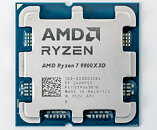
ASRock Motherboard Team Believes That Overly Fierce PBO Settings Have Damaged Ryzen 9000 CPUs
Earlier this month, Bryan Bilowol—of Tech YES City fame—was taken aback by the unexpected "death" of his Ryzen 9 9950X processor, at the alleged hands of an ASRock X870 Steel Legend motherboard. Throughout early 2025, widespread news reports and community tracking efforts have largely implicated ASRock boards. AMD's highly popular Ryzen 7 9800X3D gaming CPU has "fallen victim" on numerous occasions, but a smaller number of incidents have affected non-3D V-Cache equipped Ryzen 9000 "Granite Ridge" models. The Taiwanese manufacturer and Team Red have investigated these problems, and have released fixes via BIOS updates. Despite these efforts, unhappy owners have experienced CPU failures in Q2'25. Following the uploading of initial findings and theories, Bilowol promised further reports. Fortunately, a sit-down—with ASRock's motherboard team—happened late last week, at Computex 2025. At the time of writing, the company has not published an official statement regarding their latest findings or fixes. Tech YES City shared a couple of compelling details in a May 26 YouTube upload (viewable below).
Commenting on the Ryzen 9000 CPU failure situation, Bilowol relayed important ASRock material: (the motherboard team) told me it had to do with the EDC and TDC, which is the electric design current as well as the thermal design current. Essentially, they're saying it's an ampage problem that exists with the precision boost overdrive (PBO) settings. In particular, these mid-range and high-end motherboards—say for instance a B650E or an X670E Taichi or even a B850 Steel Legend—have the ability to run Ryzen 9000 series CPUs at their maximum PBO settings out of the box. What's happening here is ASRock told me they were implementing these settings to what they believe was too aggressive for what the CPUs were able to handle, at least for earlier samples. However, they do promise me that these issues have been fixed with their latest BIOS updates that they're rolling out for these mid-range and high-end motherboards. They also told me that the lower-end boards, say for instance, an A620 HDV or something like that, shouldn't be affected by this issue simply because those PBO settings have been deliberately tuned down, due to the motherboard in question not being a high-end model." Three months back, ASRock's Japanese branch accused the PC hardware community of spreading "misinformation." Hopefully, the latest batch of fixes will bring an end to all Ryzen 9000 CPU + high-end/mid-range ASRock mainboard controversies.
Commenting on the Ryzen 9000 CPU failure situation, Bilowol relayed important ASRock material: (the motherboard team) told me it had to do with the EDC and TDC, which is the electric design current as well as the thermal design current. Essentially, they're saying it's an ampage problem that exists with the precision boost overdrive (PBO) settings. In particular, these mid-range and high-end motherboards—say for instance a B650E or an X670E Taichi or even a B850 Steel Legend—have the ability to run Ryzen 9000 series CPUs at their maximum PBO settings out of the box. What's happening here is ASRock told me they were implementing these settings to what they believe was too aggressive for what the CPUs were able to handle, at least for earlier samples. However, they do promise me that these issues have been fixed with their latest BIOS updates that they're rolling out for these mid-range and high-end motherboards. They also told me that the lower-end boards, say for instance, an A620 HDV or something like that, shouldn't be affected by this issue simply because those PBO settings have been deliberately tuned down, due to the motherboard in question not being a high-end model." Three months back, ASRock's Japanese branch accused the PC hardware community of spreading "misinformation." Hopefully, the latest batch of fixes will bring an end to all Ryzen 9000 CPU + high-end/mid-range ASRock mainboard controversies.





















































